 AURICHALCITE
AURICHALCITE
- Chemistry: (Zn, Cu)5(CO3)2(OH)6, Zinc Copper Carbonate Hydroxide
- Class: Carbonates
- Uses: very minor ore of zinc and copper and as a mineral specimen
Specimens
Aurichalcite can be confused with Rosasite, (Cu, Zn)2CO3(OH)2. However rosasite is usually more massive but not lamellar. Rosasite crystals are harder than aurichalcite; 4 vs 1 - 2, respectively.
PHYSICAL CHARACTERISTICS:
- Color is usually a grass green but varies from white to green to greenish blue to light blue.
- Luster is silky to fibrous or pearly on more massive specimens.
- Transparency crystals are transparent to translucent.
- Crystal System is orthorhombic; 2 2 2
- Crystal Habits include radiating tufts of acicular crystals. also encrustations of fiberous or lamellar masses.
- Hardness is 1 - 2
- Specific Gravity is 3.6 - 4 (above average for non-metallic minerals)
- Cleavage is perfect in one direction.
- Fracture is uneven or fiberous.
- Streak is white to pale shades that depend on color.
- Associated Minerals include limonite, smithsonite, azurite, malachite, rosasite and calcite.
- Other Characteristics: effervesceses easily in cold dilute hydrochloric acid.
- Notable Occurrences include Bisbee, Arizona; Laurium, Greece; Tsumeb, Namibia and Mapimi, Durango, Mexico.
- Best Field Indicators are crystal habits, color, associations, softness and reaction to acid.
 Amethyst Galleries' Mineral Gallery MINERALS |
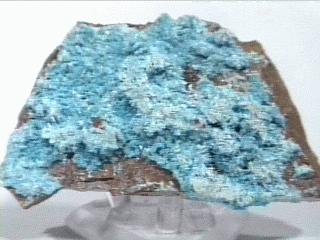
AURICHALCITE specimen aur-2
$ 30.00
$ 30.00
Dims: 3.5" x 2.38" x 1.25"(8.9 x 6.0 x 3.2)
Wt: 5.18 oz.(147.0 g)
Tecoma Hill Mine, Lucin District, Box Elder County, Utah, U.S.A.
The Aurichalcite in this specimen started out as a crust that filled a narrow fissure in a shale or fine sandstone host. That is what one sees here: the matrix from one side of the fissure, coated with a crust of beautiful, pale blue intergrowing needles. None of the crystals exceed 1/8"(3 mm), and some spots show where the crystals were growing against the now-missing side of the fissure- small chips of that host rock are still attached. Likewise, any damage done to the Aurichalcite was likely due to the separation of the host. Some areas of the crust are coated with calcite, which likely strengthened those areas. The host rock is a light red-brown in color, which provides a lovely contrast to the sky-blue needles.
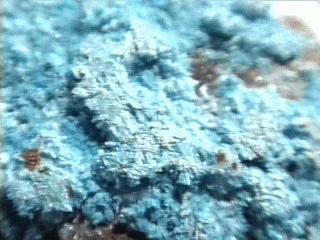

aur-2 ($ 30.00)
Tecoma Hill Mine, Lucin District, Box Elder County, Utah, U.S.A.
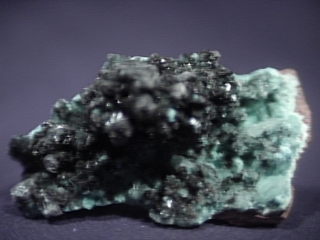
AURICHALCITE specimen aur-3
$ 42.00
$ 42.00
Dims: 2.9" x 1.7" x 1.6"(7.4 x 4.3 x 4.1 cm)
Wt: 2.98 oz.(84.4 g)
Zacatecas, Mexico
Almost half of this specimen's surface area is covered by a crust made up of clusters of short, acicular needles of Aurichalcite. These needles are pale blue in coloration, have a dull luster, are translucent, and do not exceed 0.1"(3 mm) in length. Surprisingly, there is almost no visible damage to the crystals; the reason for this is that the crystals in the most exposed areas are covered with a crust of what I believe are intergrown calcite crystals. The calcite is mostly transparent, but is almost black in coloration. The documentation states that this is due to a layer of plattnerite, that coats the specimen as a thin dusting. If it does occur in crystals, they are far too small to effectively see even with a 10-power loupe; I think that at least 100x magnification or more is necessary. All of this rests on the inevitable limonite matrix that most Mexican minerals have. Some of the exposed Aurichalcite crystals have also been "dusted" with the plattnerite, making them a bit easier to define.
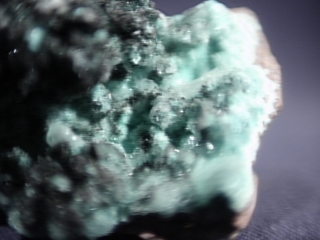

aur-3 ($ 42.00)
Zacatecas, Mexico
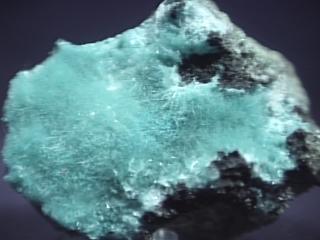
AURICHALCITE specimen aur-4
$ 50.00
$ 50.00
Dims: 2.5" x 2.0" x 1.2"(6.4 x 5.1 x 3.0 cm)
Wt: 4.49 oz.(127.4 g)
79 Mine, Hayden, Gila County, Arizona, U.S.A.
This particular specimen has a rather special addition to it. One one side of the relatively flat base rock is a thick coating that consists of hundreds of radiating Aurichalcite crystals. These crystals are about as thin as human hair and reach about 4 mm in length. They have a bright, sky-blue color and a pearly luster, and are translucent. The crust is in good condition, showing surprisingly little damage. It rests on a gray-brown host rock that is intermixed with small amounts of more Aurichalcite and what appears to be hemimorphite, and a rather impressive amount of yellow-green smithsonite that shows good botryoidal form. Parts of the smithsonite cluster are covered with thin white or brown crusts that don't interfere with its shape. The documentation that we recieved said nothing about the smithsonite, which surprised me because it is rather obvious, though coating what can be considered the "underside" of the specimen.
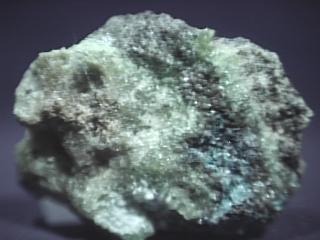

aur-4 ($ 50.00)
79 Mine, Hayden, Gila County, Arizona, U.S.A.
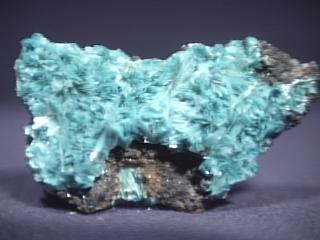
AURICHALCITE specimen aur-5
$ 25.00
$ 25.00
Dims: 2.2" x 1.3" x 0.5"(5.6 x 3.3 x 1.3 cm)
Wt: 14.4 g
Southwest Mine, Bisbee, Arizona, U.S.A.
The crust that coats the host rock of this particular specimen is made up of highly visible sprays of radiating Aurichalcite crystals. These crystals are very thin(less than 1 mm) and do not exceed 4 mm in length. They are colored pale blue, have a pearly luster, and are translucent. One spot on the crust that the crystals make up shows some obvious damage, but it is generally in good condition. It coats a base rock of goethite or limonite.

aur-5 ($ 25.00)
Southwest Mine, Bisbee, Arizona, U.S.A.
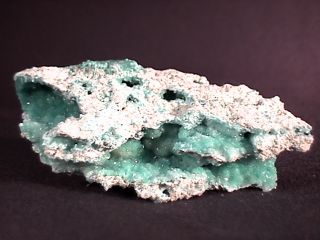
AURICHALCITE specimen aur-6
$ 35.00
$ 35.00
Dims: 3.0" x 1.5" x 0.9" (7.6 x 3.8 x 2.3 cm)
Wt: 1.91 oz. (54.2 g)
79 Mine, Hayden, Gila County, Arizona, U.S.A.
There is just enough of the chalky, cream-colored host rock on this specimen to denote the Aurichalcite-lined hollow that makes it up. This hollow is completely lined with the pale-blue mineral, which occurs in the form of crystals that do not exceed 2 mm in any dimension. Being sheltered in the hollow, they are in excellent condition, and are intergrown so as to produce many small, botryoidal formations. The crystals are a bit too large to create a silky sheen, but do show tiny flashes of a bright, pearly luster. The material appears to be nearly transparent in some areas, and is at least dimly translucent everywhere else. There are a few small crevices in the thin shell of host rock that are not directly connected with the main hollow.
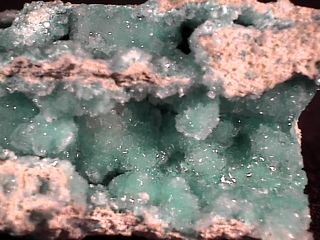

aur-6 ($ 35.00)
79 Mine, Hayden, Gila County, Arizona, U.S.A.
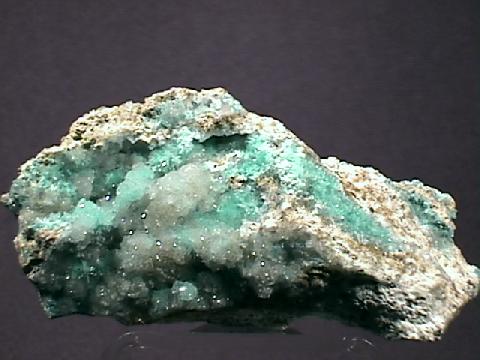
AURICHALCITE specimen aur-7
$ 36.00
$ 36.00
Dims: 3.6" x 1.8" x 1.5" (9.1 x 4.6 x 3.8 cm)
Wt: 5.27 oz. (149.5 g)
79 Mine, Hayden, Gila County, Arizona, U.S.A.
This lovely hand specimen consists of a chunk of a pale beige host rock that is interspersed with several hollows; these hollows are lined with many small clusters of fibrous, radiating Aurichalcite needles. These needles are very small, not exceeding 0.1" (3 mm) in length, and are at least as thin as a human hair. Needless to say, one cannot study their orthorhombic form without a powerful microscope. They have a pale aqua-blue color and show a satiny luster in their clustering. All are most likely translucent or transparent, and many of these clusters are coated with a druse of colorless, transparent calcite crystals (see the close-up image). There are a few deep hollows that extend into the host rock, which also contain these clusters.
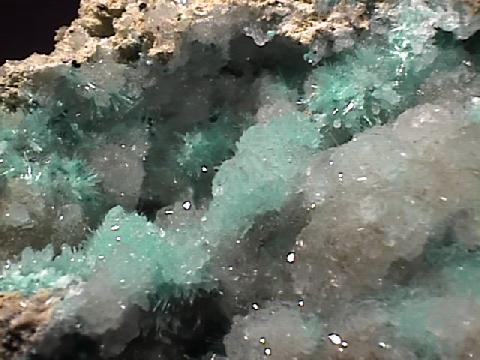

aur-7 ($ 36.00)
79 Mine, Hayden, Gila County, Arizona, U.S.A.
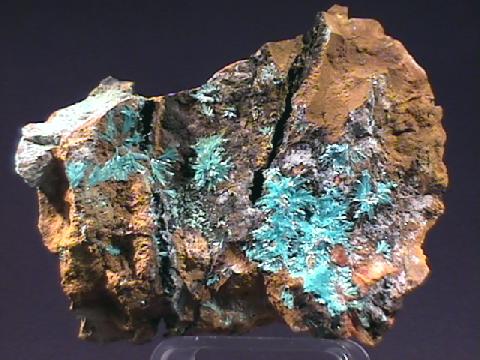
AURICHALCITE specimen aur-8
$ 55.00
$ 55.00
Dims: 4.3 x 3.6 x 2.4 " (10.9 x 9.1 x 6.1 cm)
Wt: 14.1 oz. (401.0 g)
Cave Mine, Beaver County, Utah, U.S.A.
Several flat clusters of radiating Aurichalcite needles rest on the limonite host rock of this large hand specimen. These crystals do not appear to exceed 0.4" (1.0 cm) in length or 2 mm in diameter and are generally in good condition, as they are not highly exposed. There is a small amount of visible damage, but it is minor. They are rather warped due to intergrowth, and their size makes studying them difficult, but they appear to have a good orthorhombic form. All have a pale aqua-blue coloration and a pearly luster, and though it is difficult to determine, I would think that they would be dimly transparent or at least translucent. Accompanying the Aurichalcite clusters is a thin, colorless and transparent calcite crust.
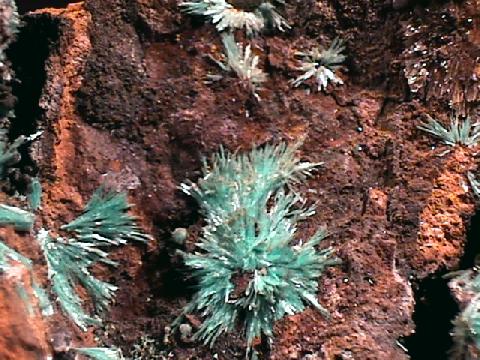

aur-8 ($ 55.00)
Cave Mine, Beaver County, Utah, U.S.A.
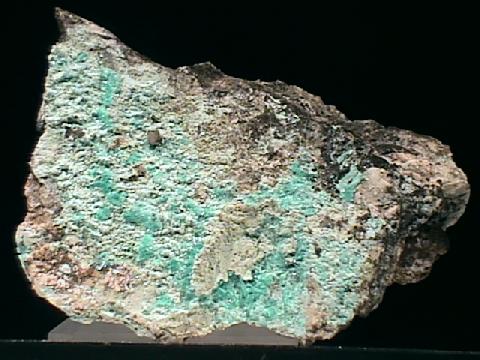
AURICHALCITE specimen aur-9
$ 25.00
$ 25.00
Dims: 3.9 x 2.8 x 1.3 " (9.9 x 7.1 x 3.3 cm)
Wt: 7.96 oz. (225.7 g)
Mapimi, Durango, Mexico
This specimen consists of many small, flattened clusters of radiating Aurichalcite needles that rest on a pale-to-dark brown host rock. These needles are generally in good condition, though a few clusters appear to be crushed, and do not exceed 2 or 3 mm in length. They are too fine and intergrown for me to effectively study with a 10-power loupe, but likely have good orthorhombic form. All have a pale blue coloration and a bright pearly luster, and are at least translucent.
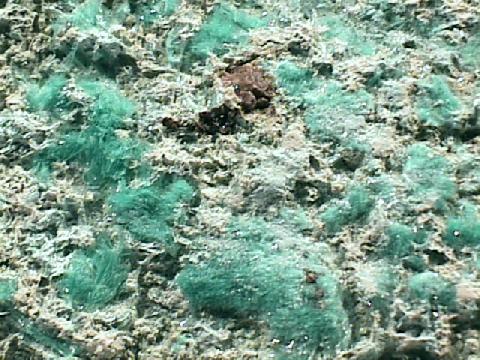

aur-9 ($ 25.00)
Mapimi, Durango, Mexico
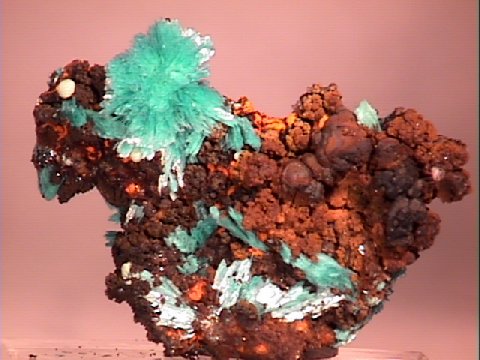
AURICHALCITE specimen aur-10
$ 42.00
$ 42.00
Dims: 1.5 x 1.2 x 0.7" (3.9 x 3.0 x 1.8 cm)
Wt: 9 g
79 Mine, Banner Mining District, Dripping Spring Mountain, Gila County, Arizona, U.S.A.
One crust and two clusters of radiating Aurichalcite blades rest on the goethite/limonite base of this thumbnail specimen. The blades are generally in very good condition and do not exceed 0.3" (8 mm) in length. Though they are rather tightly arranged, their orthorhombic bladed form appears to be quite good. They have the standard deep aqua-blue coloration and pearly luster of their specie, and are translucent. Portions of the Aurichalcite crust are coated with small amounts of the goethite/limonite base material.

aur-10 ($ 42.00)
79 Mine, Banner Mining District, Dripping Spring Mountain, Gila County, Arizona, U.S.A.
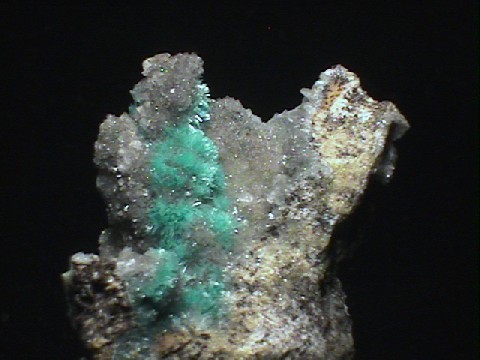
AURICHALCITE specimen aur-11
$ 100.00
$ 100.00
Dims: 2.3 x 1.6 x 1.4" (5.7 x 4.1 x 3.6 cm)
Wt: 3.5 oz. (98 g)
79 Mine, 400 Stope, Gila County, Arizona, U.S.A.
This hand specimen consists of a pale brown base rock on which rest several small Aurichalcite clusters. These clusters are generally in very good condition, as one or two show some light or moderate damage. Each cluster is made up of dozens of radiating Aurichalcite needles that do not exceed 0.1" (3 mm) in length. Their orthorhombic, spiky form is reasonably good, though a bit irregular, and all have a pale blue color with a hint of green and a pearly to silky luster. They are translucent, too. The Aurichalcite clusters rest on a druse of tiny calcites that coats a substantial portion of the host rock.
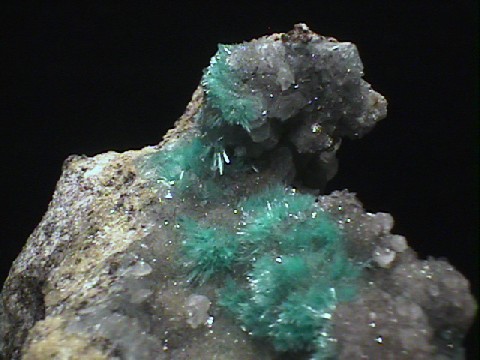

aur-11 ($100.00)
79 Mine, 400 Stope, Gila County, Arizona, U.S.A.
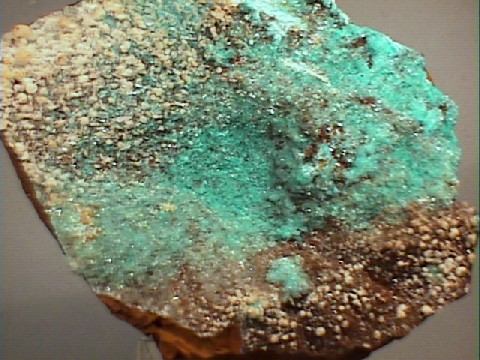
AURICHALCITE specimen aur-12
$ 27.00
$ 27.00
Dims:3.9x3.0x1.9" (9.9x7.6x4.8 cm)
Wt: 12.5oz. (355g)
Tecoma Hill, Box Elder cty., Utah
The top of this specimen is covered with radial clusters of aurichalcite to 0.1" (0.3cm) in length. These crystals range from a very pale blue to a rich sky-blue. Associated with the aurichalcite are a large number of small, tabular calcite crystals. There are a couple of dings on the face of this specimen.

aur-12 ($ 27.00)
Tecoma Hill, Box Elder cty., Utah
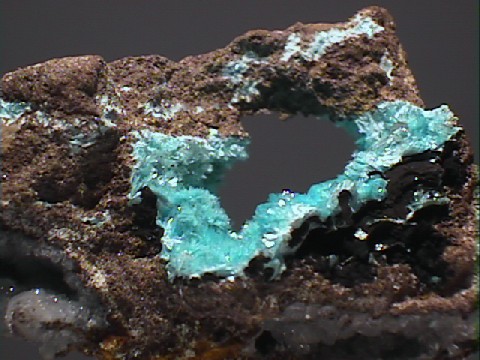
AURICHALCITE specimen aur-13
$ 25.00
$ 25.00
Dims: 1.54x0.94x0.94" (3.9x2.4x2.4 cm)
Wt: 0.45 oz. (12.7g)
General Thomas Mine, Paymaster District, Nye County, Nevada, USA
This cute thumbnail specimen has sky-blue aurichalcite crystals lining a cavity in a host rock. The crystals are translucent and well formed, showing a radial habit of larger-than-acicular crystals.

aur-13 ($ 25.00)
General Thomas Mine, Paymaster District, Nye County, Nevada, USA
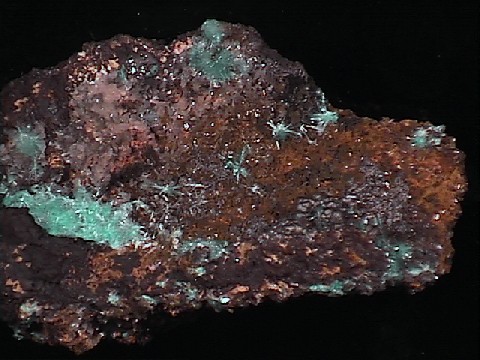
AURICHALCITE specimen aur-15
$ 60.00
$ 60.00
Dims: 3.0x1.8x1.4" (7.6x4.6x3.6cm)
Wt: 4.2oz (120g)
General Thomas Mine, Paymaster District, Nye County, Nevada, USA
This porous host rock displays many clusters of aquamarine colored aurichalcite crystals. While much of the aurichalcite is in the form of fuzzy crusts (consisting of dense clusters of tiny acicular crystals), the best crystals are large enough to be examined even without a loupe. These, too, are in radial clusters, but these clusters are loose, revealing that the aurichalcite is transparent enough that the crystals appear white individually, but a deep aqua blue at the base of each spray, where they cluster together. The host rock contains both limonite and goethite (some of the goethite is excellent), and probably other minerals as well (I am really intrigued by a nearly hexagonal curved dull black plate - it may be hematite). There are also many colorless transparent crystals that look like hemimorphite.
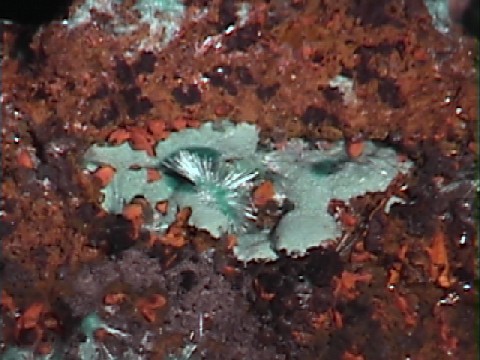

aur-15 ($ 60.00)
General Thomas Mine, Paymaster District, Nye County, Nevada, USA

AURICHALCITE specimen aur-14
$ 40.00
$ 40.00
Dims mm=74.30x66.25x39.89
wt g=191
War Eagle Mine, California, USA
A light brown rock is covered with a thin crust that looks like hemimorphite, which itself forms a backdrop to crystals of blue auricalcite and patches of a lighter blue mineral that is likely rosasite.


aur-14 ($ 40.00)
War Eagle Mine, California, USA